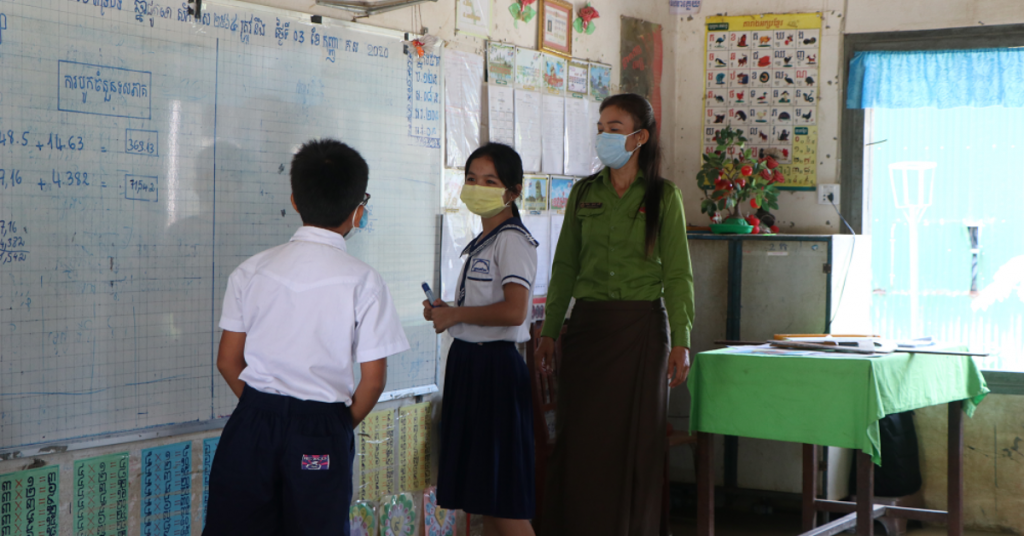Co-author: Danshipo An
5 min read
School-related gender-based violence (SRGBV) is a major obstacle to achieving gender equality. The education system provides opportunities for innovative, effective, and sustainable interventions to prevent violence against and between children, and for changes of attitudes and beliefs towards gender roles.
Ample evidence shows that teacher professional development is an effective instrument to improve teacher quality and increase student performance. However, hardly any evidence exists on the effectiveness of teacher professional development in the field of SRGBV.
Research conducted by Research Institute for Work and Society at University of Leuven, Royal University of Phnom Penh and VVOB (or education for development) have shown that effective teacher professional development on gender-responsive teaching has positive effects on the occurrence of violence experienced by students in schools (reports forthcoming in 2021). After 480 teachers from primary and lower secondary schools in Battambang province had undergone professional development with VVOB and its partners, the students have reported a decrease in emotional, physical and sexual abuse experienced at or on the way to school.
Programmes such as the “Teaching for Improved Gender Equality and Responsiveness” (TIGER) project aim to transform schools into centres of excellence for gender-responsiveness. The TIGER project ensures primary and lower secondary school children are protected from school-related gender-based violence, enabling their equitable participation in all spheres of life at school and at home.
Learning from our experience leading the TIGER project, here are some key insights on how schools can prevent SRGBV and promote gender equality.
Putting gender at the front and center of education
Centering gender in education is beneficial in changing attitudes and beliefs towards gender norms, and preventing SRGBV.
Meet Phy Srey Nich, a grade 5 learner, and her teacher, Ms Kun Theary. Both attend Samdach Chea Sim Primary School in Battambang province, Cambodia, where their school is one of 40 pilot schools of the TIGER project.
“After I attended the TIGER programme, I applied it to my teaching. For example, I mixed the female and male students, and mixed students with different abilities,” said Ms Kun Theary. As the students learnt more about gender equality and interacted more with the opposite gender, they began to challenge gender roles as well.
Through the programme, Phy Srey Nich experienced a mindset and behavioural shift towards gender equality. “I see a difference now. Girls can hang out with boys and vice versa. Girl or boy, we can do the same thing,” she said. She began to teach her siblings about gender equality at home as well, which is indicative of the influence schools have on family behaviour and societal mindsets.
Watch more short videos that capture the transformation of various stakeholders, young and old, here.
Leveraging hands-on tools for gender-responsive teaching
As Phy Srey Nich and Ms Kun Theary’s example illustrates, gender-responsive teaching comprises many aspects that are sometimes overlooked. Being aware of classroom arrangement, for example, where teachers enhance participation of both girls and boys, is a crucial aspect of gender-responsive teaching. ‘Gender-responsive classroom arrangement’ is one of 7 lessons developed for teachers in the TIGER Action Guide. Other lessons are on preparing a gender-responsive lesson plan, gender-responsive teaching materials, use of gender-responsive language and interaction, positive discipline, assessment of gender interactions and stereotypes in the classroom, and the gender-responsive teacher – a reflection. This government-endorsed Action Guide unlocks the potential of teachers and school leaders to provide all learners with opportunities to develop their own talents, irrespective of gender stereotypes.
Download the TIGER Action Guide on gender-responsive teaching and school leadership here.
Tackling gender bias amongst teachers and school leaders
Like anybody else, teachers hold on to social and cultural values and norms that consciously or unconsciously affect their teaching practices. At times, these translate into gender bias and gender discrimination in the classroom. Gender discrimination, and thus gender inequality, will continue to exist in the education sector if teachers remain biased and do not actively challenge traditional gender expectations and norms. Therefore, capacity building on gender-responsive teaching and learning methodologies is important. Teachers need to become aware of, and address, their own gender biases and belief systems, before they can tap into their potential and become real agents of change who successfully challenge gender stereotypes in their classrooms. It is up to the school management to support this transition, by putting the conditions in place that allow teachers to become aware of, and reflect on, their existing beliefs.
Applying gender-responsive pedagogy in your school will reduce the occurrence of SRGBV. It means that teachers will provide equal opportunities for all learners to engage and learn, regardless of their sex. This will provide them with the opportunity to give adequate attention to gender issues in teaching and in all interactions both within and outside the classroom.
Let us know what you think!
Gender equity can only be achieved with broad stakeholder engagement and concerted efforts. As such, we gladly invite you and any other like-minded organisations to use our materials in your activities. The Action Guide and other materials are open educational resources, while research reports are forthcoming in 2021.
VVOB welcomes any feedback and questions about the TIGER materials and we are open to discuss any queries. Please reach out to Lotte Van Praet and Danshipo An.
The TIGER project was carried out with the generous support of the European Union and Belgium.


















